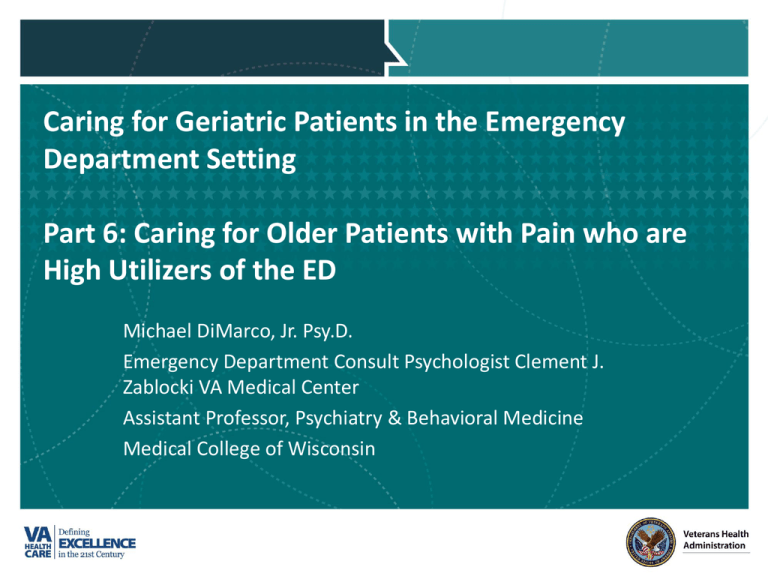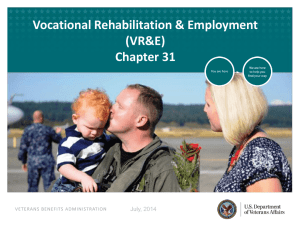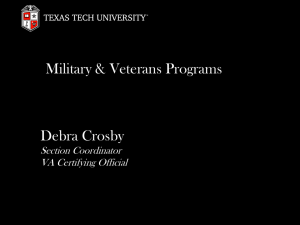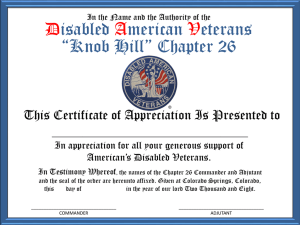
Caring for Geriatric Patients in the Emergency
Department Setting
Part 6: Caring for Older Patients with Pain who are
High Utilizers of the ED
Michael DiMarco, Jr. Psy.D.
Emergency Department Consult Psychologist Clement J.
Zablocki VA Medical Center
Assistant Professor, Psychiatry & Behavioral Medicine
Medical College of Wisconsin
Disclosures
• Michael DiMarco, Jr. Psy.D.
– No disclosures.
– No conflicts of interest to report.
VETERANS HEALTH ADMINISTRATION
1
A Common ED Dilemma
• Patient comes to ED with complaint of low back pain, longstanding, but
recent increase has been unbearable.
• There is an opiate agreement in the EHR.
• Patient has a PCP who prescribes pain medication, including opiates.
• What do you do?
VETERANS HEALTH ADMINISTRATION
2
Managing the Dilemma
1.
Believe the patient’s report of pain
2.
Assess pain using numerical, visual, or other standard pain scale
3.
Determine diagnosis
– Acute pain issue
– Exacerbation of a chronic non-cancer condition
– Disease progression
VETERANS HEALTH ADMINISTRATION
3
Managing the Dilemma
4. Review the opiate agreement in the EHR
5. Make a decision
– Administer Rx the ED i.e. injection
– Write a prescription to be filled
– Provide non-opiate medication
6. Discuss the benefits of follow up with the PCP/PS
VETERANS HEALTH ADMINISTRATION
4
Staff Reactions to Pain Patients
•
•
•
•
•
•
•
•
•
Empathy
Mistrustful
Frustration
Confrontation
Anger
Lecturing
Investigation
Delay treatment
Rush treatment – aka “treat & street”
VETERANS HEALTH ADMINISTRATION
5
“Frequent Flyers”
• Common terminology used in the ED
• Terminology may have pejorative connotations
• The terminology may negatively impact pain care.
• Consider the impact of the term.
• Consider replacing the term with “Reoccurring”
“Mr. Matthews is a 69 year old man reoccurring to the emergency
department due to persistent lower extremity neuropathic pain.”
VETERANS HEALTH ADMINISTRATION
6
“Frequent Flyers”
Reasons Patients Come to the ED for Pain Control
• Lack health insurance
• No established primary care provider (PCP) or pain specialist (PS)
• Disagreement with PCP/PS regarding the pain management plan
• Abrupt pain increase that may be exacerbated by a recent physical activity
• Pain increase due to rapid disease progression
• Fear/catastrophizing beliefs about pain
VETERANS HEALTH ADMINISTRATION
7
“Frequent Flyers”
Reasons Patients Come to the ED for Pain Control
• Regimen is not effective
– Developed a physical tolerance to the RX
– Under medicated in the first place
• Running out of RX before time of refill –Rx overuse
• Poor planning of routine prescription refills
• Addiction (personal use, self-medicating of MH condition)
• Criminal behavior -intent to sell Rx (diversion)
• Victim of abuse (patient’s Rx is being taken from them)
VETERANS HEALTH ADMINISTRATION
8
Screening for Abuse
(Screen the Patient Alone)
• “Who helps you organize your pain medications?”
• “Where do you keep your pain medications?”
• “Have you ever had to hide your medications from anyone?” If so, “Tell me
about that.”
• “Has anyone ever offered you any money for some of your medications.” If
so, “For which medications?”
• “Has anyone ever offered you food or other kind of help in exchange for
some of your medications?”
• “Has anyone ever taken your medication from you?”
VETERANS HEALTH ADMINISTRATION
9
Aberrant Medication Taking Behavior:
“To abuse or not to abuse…is the question!”
• Addiction
– Escalating Rx use with no therapeutic benefit on reducing pain
• Tolerance
– The need for increase doses of Rx to maintain the same level of pain relief
• Pseudo-addiction
– Patient appears drug-seeking but not due to addiction. Drug seeking is in the
context of being under medicated in the first place.
– Drug seeking behavior diminishes once appropriate analgesia is achieved
VETERANS HEALTH ADMINISTRATION
10
Consequences of Untreated Pain in Elderly
•
•
•
•
•
•
•
•
Further physical limitations
Loss of independence
Decreased socialization
Depression
Impaired sleep
Cognitive impairment
Increase risk for falls and other injuries
Increased healthcare utilization/cost
• Lacas & Rockwood, 2012
VETERANS HEALTH ADMINISTRATION
11
Myths About Treating Pain in the Elderly
• Analgesics are too dangerous.
• Analgesics will cause more cognitive dysfunction.
• Older people cannot accurately report pain –they’re just demented.
• Older people don’t understand pain rating scales.
VETERANS HEALTH ADMINISTRATION
12
Assessment Issues
• ED culture –fast paced and not
“geriatric-friendly.”
• Assessment biases based on
gender, race, age
• Differences in how younger vs
older patients experience pain
psychologically
• Cognitive Impairment
VETERANS HEALTH ADMINISTRATION
13
Biases in Pain Treatment
• Patients who are members of racial or ethnic minorities are under
evaluated and undertreated for painful conditions in the emergency
department.
• Some literature suggests females may receive more analgesia in the ED
than males
• Some literature suggests that elderly patients receive less analgesia
compared to their younger counterparts.
• Reference: Motov & Khan, 2009
VETERANS HEALTH ADMINISTRATION
14
Age Bias
• Jones et al. (1996) found that out of a sample of 231 hospital patients,
66% of elderly patients received less analgesia compared to 80% of their
younger counterparts.
• The study also found that elderly patients had a prolonged wait time for
administration of pain Rx, significant under dosing of pain Rx, and received
less opiate analgesics.
VETERANS HEALTH ADMINISTRATION
15
Age Bias
• Lee et al. (2006) did not find any association between advanced age,
gender, ethnicity in pain management including delays in administration of
analgesic agents among the elderly presenting with abdominal pain to an
emergency department.
• The study was unique in that it looked at the interaction of gender, race,
and age. The original hypothesis was that female, non-Caucasian, an
advanced age would expect delays in the administration of analgesia in
comparison to their younger counterparts.
VETERANS HEALTH ADMINISTRATION
16
Differences in Pain-Related Fear:
Older vs. Younger
• Younger people have more generalized pain-related fears – global
catastrophizing.
• Older people are more fearful of re-injury and further loss of autonomy
and control that comes with aging.
• Gagliese, L. (2009)
VETERANS HEALTH ADMINISTRATION
17
Pain Assessment in the Elderly
Cognitively
Impaired
Cognitively
Intact
VETERANS HEALTH ADMINISTRATION
18
General Considerations for Pain
Assessment in Elderly
• Ask about pain.
• Be aware that older patients may deny pain but endorse other
descriptions such as aching, soreness, stiffness.
• Be aware that a decrease in physical activity may be the only indicator of
pain because geriatric patients may not verbalize pain.
VETERANS HEALTH ADMINISTRATION
19
Vertical Pain Scales
• Use assessment approaches that
include both self-report and
observational measures when
possible.
• Involve the family in the
assessment of pain.
VETERANS HEALTH ADMINISTRATION
20
General Considerations for Pain Assessment
• Be aware that pain recall may pose some challenges
– pain yesterday versus pain today.
• Be aware that deficits in language skills may pose challenges in the report
of pain and explanation of pain
– i.e. stroke.
• Be aware that facial expression associated with pain may be
reduced/masked in the elderly.
• Be aware that impairments in executive function pose problems in
noticing the early emergence of lower level pain intensity.
VETERANS HEALTH ADMINISTRATION
21
Strategies for Cognitively Impaired Patients
• Don’t write these patients off.
• Reassess pain frequently.
• Minimize distractions when making a pain assessment.
VETERANS HEALTH ADMINISTRATION
22
Strategies for Cognitively Impaired Patients
• Account for both visual and auditory deficits if possible.
• Use a nonverbal rating scale.
• Pain assessment during a movement (activity during transferring, bathing,
dressing, and ambulating) is more likely to identify an underlying
persistent pain problem than observation at rest.
VETERANS HEALTH ADMINISTRATION
23
Pain Assessment in Advanced Dementia
(PAINAD)
Pain Assessment IN Advanced Dementia- PAINAD (Warden, Hurley, Volicer, 2003)
ITEMS
Breathing
Independent of
vocalization
0
Normal
1
2
SCORE
Occasional labored breathing. Noisy labored breathing. Long period
Short period of hyperventilation of hyperventilation. Cheyne-stokes
respirations.
Negative
vocalization
None
Facial expression
Occasional moan or groan.
Repeated troubled calling out. Loud
Low- level of speech with a
moaning or groaning. Crying
negative or disapproving quality
Sad, frightened, frown
Facial grimacing
Smiling or
inexpressive
Relaxed
Tense. Distressed pacing.
Fidgeting
Body language
Consolability
Rigid. Fists clenched. Knees pulled
up. Pulling or pushing away. Striking
out
No need to Distracted or reassured by voice Unable to console, distract or
console
or touch
reassure
TOTAL*
* Total scores range from 0 to 10 (based on a scale of 0 to 2 for five items), with a higher score indicating more severe pain (0=”no
pain” to 10=”severe pain”).
VETERANS HEALTH ADMINISTRATION
24
Coordinated Care
• View alert
– PCP
– PC-SW
– PC-psychologist
• Referral to the PC
Home-Based Program
VETERANS HEALTH ADMINISTRATION
25
Management & Follow-up Care
Coordination for Older Patients
with Pain in the ED
Jelili A. Apalara, MD, MPH, FACP, CPE, FACHE.
Assistant Clinical Professor of Medicine,
University of California, San Francisco
Medical Director – Emergency Dept.
VA Central California Healthcare System
MARCH 2014
Disclosure
VETERANS HEALTH ADMINISTRATION
27
Objectives
By the End of this Presentation, participants will be able to:
• acquaint themselves with the consequences of inadequate pain
treatment in the Elderly.
• familiarize themselves with the legal position on pain
management.
• describe different modalities for pain management in the Elderly.
• recognize their roles in subsequent follow-up and management of
the patients.
VETERANS HEALTH ADMINISTRATION
28
Recommendation Grading
Evidence Quality
High
1
Moderate
2
Low
3
Strength of Recommendation
Strong
A
Weak
B
Insufficient
I
VETERANS HEALTH ADMINISTRATION
29
Introduction
• In 2009, the Elderly
population, persons 65
years and older,
represents only one
out of every eight
Americans.
• This denoted 12.9% of
the US population., or
39.6 million people in
that year.
VETERANS HEALTH ADMINISTRATION
30
Introduction
VETERANS HEALTH ADMINISTRATION
(Based on online data from the U.S. Census Bureau’s 1) Population Estimates and Projections; 2) Table
1. Projected Population by Single Year of Age (0-99, 100+), Sex, Race, and Hispanic Origin for the
31
United States: July 1, 2012 to July 1, 2060, Release Date: 2012; and 3) Table 5. Population by Age and
Sex for the United States: 1900 to 2000, Part A. Hobbs, Frank and Nicole Stoops, Census 2000 Special
Reports, Series CENSR-4, Demographic Trends in the 20th Century.)
Realities and Challenges
• One major challenge faced by the elderly people is physical
disability.
• Physical disability in this group often worsens with age.
• Majority have at least one chronic medical problem, and many
have multiple chronic conditions.
• Arthritis and degenerative joint disease top the list, and often
associated with Pain.
VETERANS HEALTH ADMINISTRATION
Types of Pain
VETERANS HEALTH ADMINISTRATION
33
Pain should be
Evaluated and
Treated in the
Elderly.
VETERANS HEALTH ADMINISTRATION
34
Treating Pain is Both
a MORAL and an
ETHICAL
responsibility for
Healthcare Providers.
VETERANS HEALTH ADMINISTRATION
35
The mission of DEA's Office of Diversion
Control is to prevent, detect, and
investigate the diversion of controlled
pharmaceuticals and listed chemicals
from legitimate sources while ensuring
an adequate and uninterrupted supply
for legitimate medical, commercial, and
scientific needs.
VETERANS HEALTH ADMINISTRATION
36
Consequences of Untreated Pain
Functional
Impairment.
Depression.
Increased
Suicide Risk.
Increased
Mortality.
VETERANS HEALTH ADMINISTRATION
37
Treatment Modalities
Pharmacologic
Physical Therapy
Interventional
TREATMENT
MODALITIES
Surgical Procedure
Behavioral Medicine
VETERANS HEALTH ADMINISTRATION
Neuromodulation
38
Treatment Modalities
NSAIDs
Tramadol
Opioids
Muscle Relaxants
Antidepressants
α2 adrenergic agonists
NMDA-ra
Anti-epileptics
Topical Agents
VETERANS HEALTH ADMINISTRATION
39
Pharmacological Treatment
WHO’s Pain Relief Ladder
VETERANS HEALTH ADMINISTRATION
WHO 1980.
40
Pharmacological Treatment
• WHO recommends a progressive increment in doses and
types of analgesic to ensure effective pain management.
• Modality of treatment is not static, it changes with the
characteristics of the pain.
• Mild pain should be treated with acetaminophen, aspirin or
other Non-steroidal Anti-inflammatory Drugs (NSAIDs).
• Moderately persistent or worsening pain requires addition of
opioid such as codeine or hydrocodone.
VETERANS HEALTH ADMINISTRATION
41
Pharmacological Treatment
• Opioids with fixed dose acetaminophen provides additive
analgesia.
• If pain worsens, and higher doses of opioid are necessary,
separate dosage of opioid and non-opioid analgesic.
• This ensures maximally recommended doses of acetaminophen
or NSAIDs are not surpassed.
• Severe pain requires more potent opioids, such as morphine,
hydromorphone, methadone or fentanyl.
VETERANS HEALTH ADMINISTRATION
42
Pharmacological Treatment
• Patients with persistent cancer-related pain should be on
around-the-clock schedule, with additional “PRN" doses.
• Patients who have moderate to severe pain when first seen by
the clinician should be started at the second or third step of
the ladder.
• Adjuvant drugs should be used at any step as necessary to
enhance analgesic efficacy and treat concurrent symptoms
exacerbating pain.
VETERANS HEALTH ADMINISTRATION
43
44
VETERANS HEALTH ADMINISTRATION
45
Geriatrics Pain Management
VETERANS HEALTH ADMINISTRATION
46
Physician’s Role
Social Work
Behavioral Medicine
PHYSICIAN
&
PATIENT
Interventional
Physical Therapy
VETERANS HEALTH ADMINISTRATION
Physicians and Other Healthcare Providers are central to
ensuring effective interdisciplinary pain management. 47
Interdisciplinary Pain Management
GOALS
• Pain Reduction.
• Increased activity levels.
• Increased functionalilty.
• Early return to work or vocation.
• Reduced opioids use or more appropriate dosing.
• Reduced depression and anxiety.
• Improved coping skills.
• Reduced use of medical resources
VETERANS HEALTH ADMINISTRATION
48
Interdisciplinary Pain Management
VETERANS HEALTH ADMINISTRATION
Proc (Bayl Univ Med Cent). Jul 2000; 13(3): 240–243.
49
Key Points
Key Points
Acetaminophen should be considered as initial and ongoing pharmacotherapy
in the treatment of persistent pain, particularly musculoskeletal pain, owing to
its demonstrated effectiveness and good safety profile (1-A).
Most patients with moderate to severe pain, pain-related functional
impairment, or diminished quality of life due to pain should be considered for
opioid therapy (3-A).
Most patients with neuropathic pain are candidates for adjuvant
analgesics (1-A).
Most patients with localized neuropathic pain are candidates for topical
lidocaine (2-A) or capsaicin.
Pharmacological Management of Persistent Pain in Older Persons. JAGS. 2009.
VETERANS HEALTH ADMINISTRATION
50
Key Points
Patients should not take more than one nonselective NSAID or COX-2 selective
inhibitor for pain control (3-A).
Clinicians should anticipate, assess for, and identify potential opioid-associated
adverse effects (2-A).
Only clinicians well-versed in the use and risks of methadone should initiate it.
Methadone must be titrated cautiously (2-A).
Long-term systemic corticosteroids should be reserved for patients with painassociated inflammatory disorders or metastatic bone pain. Osteoarthritis
should not be considered an inflammatory disorder (2-A).
Therapy should begin with the lowest possible dose and increase slowly based
on response and side effects, with the caveat that some agents have a delayed
onset of action and therapeutic benefits are slow to develop. For example,
gabapentin may require 2 to 3 weeks for onset of efficacy (2-A).
Pharmacological Management of Persistent Pain in Older Persons. JAGS. 2009.
VETERANS HEALTH ADMINISTRATION
51
Conclusion
Optimal Pain Control
improves elderly patient’s
quality of life!
Pharmacological Approach
should not be the only
focus of management!!
VETERANS HEALTH ADMINISTRATION
Interdisciplinary and
Collaborative Approach
provide better
management outcomes in
Elderly patients.
52
VETERANS HEALTH ADMINISTRATION
53








